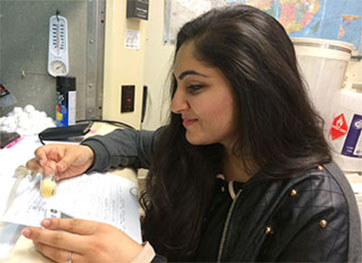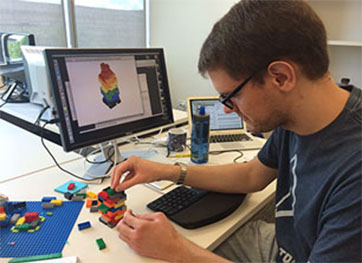Turning Cancer to Fat, Drunk Fruit Flies Among Student Projects
NSM Undergrads Spent Summer Making a Difference with Hands-on Research
Seeking eventual solutions to problems ranging from alcoholism and cancer to finding better ways to use Lego models to build bridges, University of Houston students devoted the summer to some serious scholarship.
Delving into a number of complex projects over the course of 10 weeks, 27 College of Natural Sciences and Mathematics undergraduates received $3,500 stipends for an intensive, full-time research experience in the Summer Undergraduate Research Fellowship program. Students were mentored by UH faculty members from NSM and other colleges.
Twenty-one NSM faculty members hosted students in their labs.
“Cancer is something I have experienced through many family members and have seen in helpless children in the pediatric ward of hospitals I volunteered in,” said biomedical sciences sophomore Radhini Abeysekera. “When I saw the opportunity to work in a lab doing research on osteosarcoma, a cancer that usually targets children and teenagers, I was very interested to get a look behind the scenes.”
Working under the mentorship of professor Preethi Gunaratne in the Department of Biology and Biochemistry, Abeysekera is studying a specific type of RNA that may be able to control what a cell matures into, possibly being able to convert cancer cells to fat cells, which are easier to eliminate than cancer.

Khadeeja Tarique is studying how alcohol changes brain activity that can result in alcoholism.In another project from the Department of Biology and Biochemistry, Khadeeja Tarique is studying under the direction of professor Gregg Roman as the recipient of an additional scholarship from the Biology of Behavior Institute.
“In the Roman lab, we are trying to understand how alcohol changes activity of the neurons within the brain to bring about tolerance and other behavioral changes that can result in alcohol abuse and addiction,” said Tarique, a biology major. “We are studying the effect of alcohol on neural activity using fruit flies. Once we understand which proteins alcohol interacts with to bring about these changes, we can then use these proteins to develop drugs to interfere with this interaction, which may inhibit the formation of tolerance and help stop people from becoming addicted to alcohol.”
Ason Jablinski is creating an iPad app that guides the construction of Lego models in hopes of one day applying this research to create blueprints for bridges and buildings.On a lighter note, computer science major Anson Jablinski is using his knowledge in software design to create an iPad app that guides the construction of Lego models. While his summertime project is more for entertainment value, he envisions future versions of his application being able to scan any 3-D object and design a Lego model for it.
“I imagine biology students building proteins or physics students modeling bridges. Custom models for any educational application could be created and automatically sent to classrooms everywhere,” he said. “Eventually, we may even be able to scan a Lego model for creating life-size blueprints for actual buildings.”
Working under the supervision of professor Ioannis Kakadiaris in the Computational Biomedicine Lab, Jablinski says his summer research experience has helped him decide what to do after finishing his undergraduate studies at UH, giving him insight to the mindset and dedication required to pursue graduate work at the master’s and Ph.D. levels.
This year’s summer research program wraps up Aug. 8, and by the end, the students will be prepared to present research posters on their projects at UH’s 10th annual Undergraduate Research Day Oct. 9.
- Excerpted from article by Lisa Merkl, University Communication
